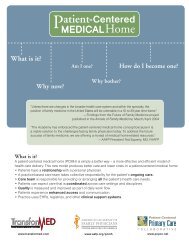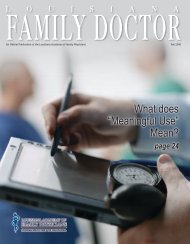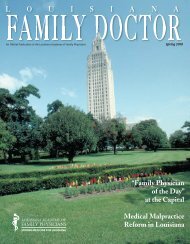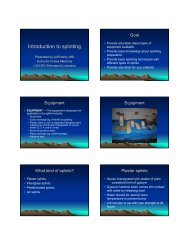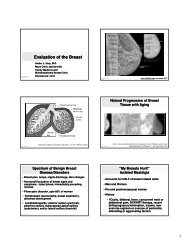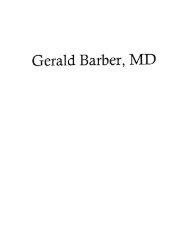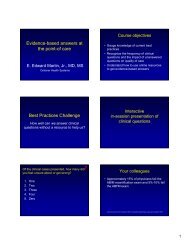New Drug Update 2009-2010 - LAFP
New Drug Update 2009-2010 - LAFP
New Drug Update 2009-2010 - LAFP
Create successful ePaper yourself
Turn your PDF publications into a flip-book with our unique Google optimized e-Paper software.
SAXAGLIPTIN - Onglyza (Bristol-Myers Squibb / Astra Zeneca) 1S<br />
INDICATIONS: Saxagliptin is indicated for use as an adjunct to diet and exercise to improve glycemic<br />
control in adults with type 2 diabetes mellitus. It has been evaluated for use as monotherapy or in<br />
combination with other antidiabetic agents, including metformin, sulfonylureas, and thiazolidinediones. It<br />
has not been assessed in combination with insulin.<br />
Saxagliptin and sitagliptin share the same Food and <strong>Drug</strong> Administration (FDA)-approved indication.<br />
CLINICAL PHARMACOLOGY: Saxagliptin is a reversible, competitive dipeptidyl peptidase-4 (DPP-4)<br />
inhibitor. DPP-4 inhibitors lower blood glucose by preventing the breakdown of glucagon-like peptide-1<br />
(GLP-1) and glucose-dependent insulinotropic polypeptide (GIP), thus prolonging the activity of these<br />
peptides. Saxagliptin is 10-fold more potent than sitagliptin and vildagliptin at inhibiting DPP-4. The<br />
saxagliptin active metabolite is 2-fold less potent than saxagliptin. Both saxagliptin and its active<br />
metabolite are more selective for inhibition of DPP-4 than DPP-8 (400- and 950-fold) and DPP-9 (75- and<br />
160-fold). Saxagliptin and its active metabolite have exhibited slow dissociation from DPP-4, with a halflife<br />
of dissociation of 50 and 23 minutes, respectively. Plasma DPP-4 inhibition 24 hours after saxagliptin<br />
2.5 and 400 mg doses was 50% and 79% of predose, respectively. Maximal inhibition was observed at a<br />
150 mg dose.<br />
After an oral glucose load or meal, saxagliptin DPP-4 inhibition results in a 2- to 3-fold increase in<br />
circulating levels of active GLP-1 and GIP, decreased glucagon concentration, and increased insulin<br />
secretion from pancreatic beta-cells.<br />
PHARMACOKINETICS: Saxagliptin has high oral bioavailability (75% in animal models). Systemic<br />
exposure is dose-proportional over doses from 2.5 to 400 mg. Peak concentrations (C max ) of saxagliptin<br />
are reached within 2 hours of oral administration; C max of the active metabolite are reached within 4 hours.<br />
Administration with a high-fat meal slightly delayed absorption (approximately 20 minutes), but was<br />
associated with a 27% increase in overall exposure.<br />
Saxagliptin is metabolized via CYP 3A4/5. Mean saxagliptin half-life is 2.2 to 3.8 hours; the half-life of the<br />
active metabolite is 3 to 7.4 hours. 6 Approximately 70% of the dose is recovered in the urine as<br />
saxagliptin or the active metabolite; 12% to 29% was recovered as the parent drug.<br />
Saxagliptin pharmacokinetics did not differ by gender, although levels of the active metabolite were<br />
increased approximately 25% in females.<br />
Saxagliptin C max were increased 1.2-fold and area under the curve (AUC) values were increased 1.6-fold<br />
in elderly subjects compared with younger subjects. Elderly subjects had a greater volume of distribution<br />
and reduced metabolic and renal clearance of saxagliptin. Age-related decline in renal function accounted<br />
for 50% of the difference in pharmacokinetics. Dosage adjustments on the basis of age are not<br />
necessary.<br />
In patients with hepatic function impairment (Child-Pugh class A, B, or C), a trend toward increased<br />
saxagliptin levels (AUC increased 10% to 77%) and reduced levels of the active metabolite (AUC reduced<br />
by 7% to 33%) were observed; however, routine dosage adjustments do not appear necessary.<br />
In patients with mild renal impairment, the AUC of saxagliptin and its active metabolite were 20% and<br />
70%, higher, respectively, than those in patients with healthy renal function. In patients with moderate to<br />
severe renal impairment, AUC levels of saxagliptin and its active metabolite were up to 2.1- and 4.5-fold<br />
higher than in patients with healthy renal function. Dose restrictions are advised for patients with<br />
moderate and severe renal impairment and patients with end-stage renal disease requiring hemodialysis.<br />
23




